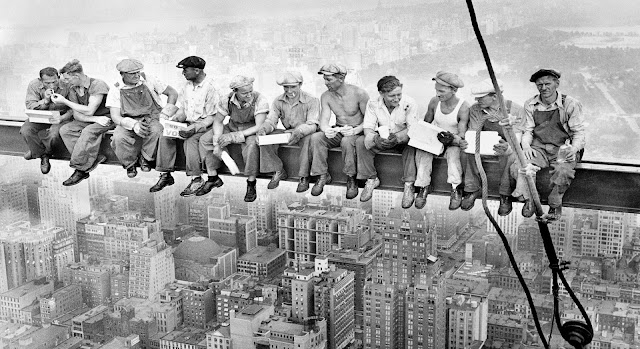Hi everybody!
This is our last post and today we are going to talk
about the famous bridge from New York City: the Brooklyn Bridge.
Brooklyn Bridge, an icon from the
city, is a suspension bridge which connects Manhattan and Brooklyn
through the East River. It was completed in 1883 and it is one of the
oldest bridges of the United States. It was designated a National
Historic Landmark in 1964 and a National Historic Civil Engineering
Landmark in 1972.
The construction of the bridge began
in 1869. It was initially designed by German John Augustus
Roebling, who had previously designed and constructed shorter
suspension bridges, but this one has a main span of 486.3 m and
was the first steel-wire suspension bridge constructed too, with
hybrid cable. For its towers, it was used limestone, granite and
Rosendale cement.
While the construction was being done,
Roebling had an injury that made his condition unable to physically
supervise the construction. So, the solution was Roebling conducted
the entire construction from his apartment with a view of the work.
His wife, Emily Warren Roebling, helped him too providing the
critical written link between her husband and the engineers and, as
she had to supervise the bridge under her husband's guidance, Emily
studied higher mathematics to understand in a better way his
instructions. Finally, in May 24th 1883, the bridge was complete and
ready to be inaugurated.
The day it was opened, there was a big
ceremony where thousand people and many ships were present in the
East Bay for the occasion. The president Chester A. Arthur and the
Mayor from the city, Franklin Edson, were the first ones to pass the
bridge. As Roebling was unable to go to the ceremony, Arthur shook
hands with him at his house after the ceremony and Roebling held a
party banquet in the same day of the bridge opening. There were more
festivities to celebrate the opening. For example, the performance of
a band, gunfire from ships, and a fireworks display.
The bridge was renovated right now, we
can say. The idea to renovate it began in 2010, with a plan that the
full bridge was going to be renewed. The renovation began in spring
2011 and was originally scheduled to run until 2014, but the project
was delayed to April 2015.
Cultural references
You know this bridge has been noticed
in the culture. For example, Cuban poet José Martí wrote an article
titled "The Bridge of Brooklyn" for the magazine La
América, published in June 1883, shortly after the bridge opened to
the public.
American Modernist poet Hart Crane
used the Brooklyn Bridge as a central metaphor for his second and
most important book of poetry, The Bridge.
Painting had also its pieces. For
example, Albert Gleizes and his painting Brooklyn Bridge (Pont de
Brooklyn). The bridge has been shown in films such as Gangs of New
York, Kate & Leopold, It Happened in Brooklyn and other ones. It
has been also shown in television series such as How I Met your
Mother or CSI: NY.
Opinion and details
We all know how this bridge is an icon
from New York. It is not only a big bridge, but also it is beautiful
designed, and we can tell it was curious how it was completely
constructed. However, the result is a bridge highly known and visited
that almost everyone thinks that is gorgeous. We can also tell that at night,
when the lights turn on in the bridge, it is awesome, as you can see on this picture:
By the time the bridge was
constructed, it was the longest bridge in the world. People started
to give names, like New York and Brooklyn Bridge or East River
Bridge, but finally it was officially called Brooklyn Bridge. As you
may know, it is also a pedestrian bridge.
This one is the last post of this blog. We really hope you have all enjoyed reading our weekly posts and learning a little about the American painting, sculpture, architecture and photography. We have tried to explain this extensive topic in an amusing and simply way so it would be pleasant and entertaining for you. We say you good bye hoping you have learnt at least a little about American art.
Even if the blog is done you can leave any comment or ask us whatever you want. We will be happy to answer questions about American art.
Until forever,
Carolina, Fani, Franny, Gloria and Patricia ✿
This one is the last post of this blog. We really hope you have all enjoyed reading our weekly posts and learning a little about the American painting, sculpture, architecture and photography. We have tried to explain this extensive topic in an amusing and simply way so it would be pleasant and entertaining for you. We say you good bye hoping you have learnt at least a little about American art.
Even if the blog is done you can leave any comment or ask us whatever you want. We will be happy to answer questions about American art.
Until forever,
Carolina, Fani, Franny, Gloria and Patricia ✿
Bibliography:
-
History - Roebling: The Story of the Brooklyn Bridge
-
http://www.encyclopedia.com/topic/Brooklyn_Bridge.aspx











